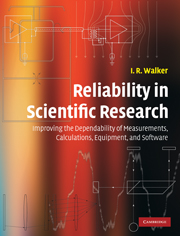 Reliability in Scientific Research
Reliability in Scientific Research Published online by Cambridge University Press: 05 June 2012
Introduction
Mechanisms in general are a notorious source of reliability problems. This chapter deals with mechanical devices and systems (broadly construed) that are of particular concern in experimental work. The former include precision mechanisms, static and dynamic vacuum seals, and valves. A brief discussion of devices for preventing mechanical overtravel and overload is also included.
Mechanical devices that are used under extreme conditions (e.g. in ultrahigh-vacuum and cryogenic environments) often suffer from friction and wear problems due to a lack of lubrication. A section of the chapter is devoted to lubricants (and especially dry lubricants and self-lubricating solids) that are useful under such conditions.
Water-cooling systems are a common source of trouble in apparatus ranging from small-scale tabletop equipment (e.g. lasers) to large particle accelerators. Such problems include leaks, cooling-line blockages, corrosion, and condensation. These issues, and others, are discussed below.
Mechanical vacuum pumps are dealt with in Chapter 7, while electrical connectors and cables (which are partly mechanical devices) are discussed in Chapter 12.
Mechanical devices
Overview of conditions that reduce reliability
Some agents and environmental conditions that tend to diminish the reliability of mechanical parts and systems are as follows.
(a) Particulate matter such as dust and grit can be very harmful to mechanical devices. It leads to accelerated wear and damage of moving parts (especially antifriction bearings, such as ball bearings), leaks in sealing devices, a decrease in the accuracy of precision mechanisms, and instabilities in mechanical assemblies requiring accurate registration of surfaces.
(b) Moisture (including high humidity) causes corrosion and promotes biological growth (i.e. mold and fungi, which can release corrosive chemicals), degrades lubricants, and holds particulate matter that would otherwise escape on surfaces. […]
To save this book to your Kindle, first ensure [email protected] is added to your Approved Personal Document E-mail List under your Personal Document Settings on the Manage Your Content and Devices page of your Amazon account. Then enter the ‘name’ part of your Kindle email address below. Find out more about saving to your Kindle.
Note you can select to save to either the @free.kindle.com or @kindle.com variations. ‘@free.kindle.com’ emails are free but can only be saved to your device when it is connected to wi-fi. ‘@kindle.com’ emails can be delivered even when you are not connected to wi-fi, but note that service fees apply.
Find out more about the Kindle Personal Document Service.
To save content items to your account, please confirm that you agree to abide by our usage policies. If this is the first time you use this feature, you will be asked to authorise Cambridge Core to connect with your account. Find out more about saving content to Dropbox.
To save content items to your account, please confirm that you agree to abide by our usage policies. If this is the first time you use this feature, you will be asked to authorise Cambridge Core to connect with your account. Find out more about saving content to Google Drive.